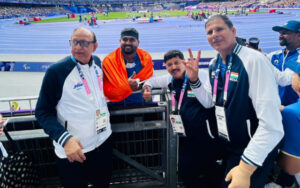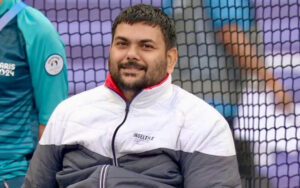
Sharmistha Gooptu in Paris
September 4 was an exalted day for India in the Paris Paralympics. First, Harvinder Singh bagged a gold medal in archery and shortly thereafter both gold and silver went to India in men’s F51 Club Throw. Dharambir won the gold and Pranav Soorma took the silver. Next morning, I was having a chat with Satyanarayan ji, the head coach of the Indian para-athletics contingent, and I happened to say that the medal count predicted was certainly well on track, and that we had crossed the Tokyo medal tally.
He corrected me. It is not so easy to predict medals in all categories in para-sport. For some athletes it’s that particular day or the day before or the intervening days between competitions that count, and how well they recover in between becomes critical. There are athletes who are placed in the classes with severe disabilities. Take those who won India the gold and silver in Club Throw for instance. Satya ji told me (transcribed in essence from the conversation): “There is the issue of urine obstruction. Everyday they cannot have the same level of bladder clearance. And that causes irritation and can affect their performance.
“Secondly, their hands cannot hold properly – suppose they have six throws, four might be wasted and then they have just two. And they can fail even in those two. Third, their body immunity is very low. If they have a urine infection, they might have fever and their body immunity is lowered. It’s the lowest for the F51 class.”
For the Latest Sports News: Click Here

Such factors and other things can lead to yo-yoing of the athletes’ performances to extreme levels. As Satyaji explained: “Abhi Dharambir gold jeet gaya. Yeh ladka World Championships mein jaane ke liye qualify nahi kiya tha (Now, Dharambir has won the gold. The boy didn’t qualify for the World Championships).
“There was a competition in the month of May in Kobe, Japan. He was not even qualified to go and participate there. Then, I made a decision, because his performance was good – to send on one’s own cost. In such cases we cannot send (an athlete) on the government’s cost. Other athletes may object, so we have to send at one’s own cost.”
There are other associated factors for these athletes in the severe disability classes. Satya ji further informs that these athletes need a certain kind of maintenance. They need assistants who can lift them and handle their higher body weight of 85 kgs, 90 kgs or more. “85-90 uthane wala chahiye. Thoda sa bhi hila diya usko toh performance affect ho jayega (Need those who can lift 85-90 kgs. Even a little bit of transgression can affect performance)… He should be strong.’

Satyanarayan ji signed off with a message – the winners of gold and silver medals in this category of severe disability should carry the message for others with severe disability, that they too can take up sports. Surely they can, and it’s a way for them to get their story and their perspective across to a lot more people.
The Paralympics has been a learning curve every day and every step of the way. How much work goes behind the performance of a para-athlete needs to be appreciated and the support staff, medical personnel and officials be acknowledged for the job that they have been doing.